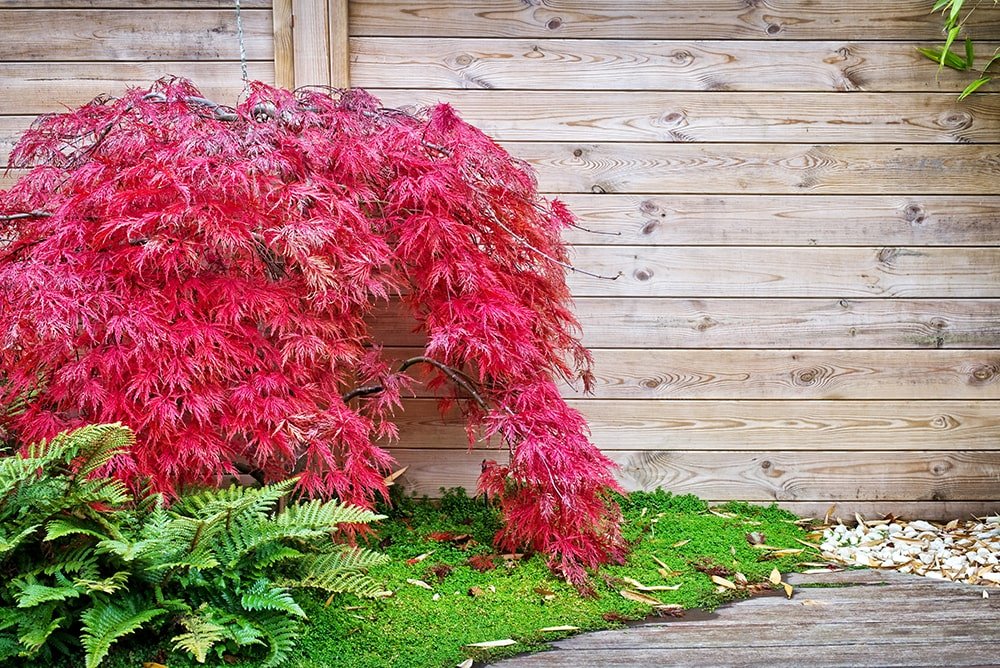THE FALL PLANTING SEASON IS JUST AROUND THE CORNER
Knowledgeable gardeners know that fall is the best season for planting trees and shrubs. The main reason is that our soil temperature is warm in the fall and our air temperature will be cooler. This combination helps to reduce the stress that plants can face while being planted. This logic applies to the planting of Japanese Maple trees this fall.
Are you awed by the beauty of Japanese maple trees? I sure was when I was the buyer of trees and would make yearly trips out to Oregon to do my purchasing for the garden center. In Oregon, Japanese maple trees are planted everywhere—even in the landscape of gas stations in Portland, which made me laugh. But, here I am some thirty years later, and I am still in awe of seeing all the beauty of Japanese maple trees and what they offer to a landscape.
When you come to the garden center to investigate the possibility of purchasing a Japanese maple tree then be prepared to be overwhelmed by all the different varieties and all their beauty. There are thousands of different, named varieties of Japanese Maple trees. All these different varieties fall under two different family types of maple trees. You have the palmatum types, which are your upright, ornamental growing types. The most common variety is the Bloodgood. The second family type of maple is the dissectum. The dissectum varieties are your “weeping” maples with leaves that are deeply cut and finely lobed giving a lace cutout look. A couple very popular varieties of dissectum are: Crimson Queen, Tamukeyama, and Virdis.
So, now that it is still August, now is a good time to go onto the internet or visit the garden center and start the educational process. Study all the different varieties that you see. Most maples will have either a green or red leaf. But, some very good varieties have variegated leaves. One unique variety of palmatum is called Coral Bark. This variety has beautiful coral-colored bark and trunks. This one sure is a show stopper—especially in the winter when there are no leaves on the tree showing off the beautiful colored bark.
LEAF SHAPE
As I mentioned earlier, there are two family types of Japanese maple trees. The Palmatum family types have more of the traditional maple leaf shape but will be smaller. The Dissectum (weeping) form of maples has leaves that are deeply cut and finely lobed—hence the nickname of Laceleaf.
PLANTING LOCATION
Japanese Maple trees can be somewhat challenged in Central Virginia, especially during the hot, humid, summer months. So, ideally most Japanese maple trees would grow best in some shade in order to reduce leaf scorching. Leaf scorching is somewhat common on maples. You will see the tips of the leaves crusty brown. This is not a disease. It is just the nature of growing Japanese maple trees in Central Virginia.
LEAF COLOR
The leaf color and shape will vary depending on the variety. In spring the Japanese maple trees have glorious red or green leaves. Some of the red leaf varieties will see a color change with their leaves once summer arrives. Some varieties have variegated leaves of white, gold, pink, or cream. Be aware that those maple trees with the variegated leaves burn easily in the full afternoon sun so be sure to plant these varieties in morning sun only and afternoon shade.
GROWING HABITS
The upright Palmatum varieties of Japanese maple trees have an upright growing habit. Very ornamental in look and structure. Most will grow to be 20’/25’ tall and about just as wide. The weeping “laceleaf” dissectum varieties will grow to become about 6’/8’ tall but will become 12’/15’ wide. With either variety be sure to understand the growing dimensions and plant accordingly that will accommodate the eventual growing sizes.
Come see us for assistance. Once you decide the planting location and the type of Japanese maple you prefer, we would be honored to have you come see our selection of maple trees.
PLANT A LITTLE HAPPINESS THIS FALL!!!!!!!!!!!!!!!!!!

